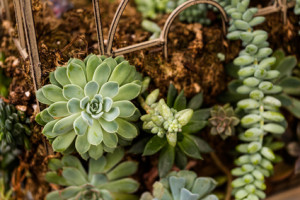Xeriscape Landscaping Ideas for Easy Gardening
 Xeriscape is a type of gardening that focuses on conserving water. You typically won’t see any lush green lawns; instead, xeriscape yards and gardens are full of local and drought-resistant plants, and typically involve creative uses of windbreaks and drip irrigation. They’re gaining popularity not just for their eco-friendliness, but because they’re very easy to maintain.
Xeriscape is a type of gardening that focuses on conserving water. You typically won’t see any lush green lawns; instead, xeriscape yards and gardens are full of local and drought-resistant plants, and typically involve creative uses of windbreaks and drip irrigation. They’re gaining popularity not just for their eco-friendliness, but because they’re very easy to maintain.
This school of gardening breaks a lot of the rules that many landscapers follow. It can be tricky to know where to get started, but here are a few ideas.
Research Xeriscape and Use Local Plants
We can’t advise you about what plants you should be using, because it’s particular to your region and your aesthetic tastes. Ideally, you want to rely as much as possible on rainfall, and the best way to do that is to use drought-resistant plants that are adapted to your area. Exotics are typically harder to maintain, and invasives often suck up water. An added benefit to choosing local plants is that local wildlife will seek your xeriscape garden out!
So head to your local library, check online, or go through a local greenhouse and ask questions of the staff there. Landscaping 101 applies here: be sure you’re choosing plants that will thrive in your soil’s pH, and with the different amount of sunshine your xeriscape gets. Remember to choose a variety of colors, and try to choose plants that will bloom over the course of the year rather than all at once.
Compost Before You Plant
After your plants are in the ground, it can be tricky to compost your xeriscape. Instead, add the compost while you’re prepping the soil for your plants. This doesn’t just make the soil richer — it also helps it retain moisture.
Permeable Paving
Asphalt, tile, or other paving surfaces catch water and cause it to puddle and eventually evaporate, where it’s lost. This “hardscaping” can also become very hot in the sun, which affects moisture absorbtion and can make your plants wilt. Using gravel, sand, or a comparable paving material on your paths lets water seep down into the soil to water your xeriscape plants.
Grade on a Curve!
Try adding a slight grade, or even terracing, to your xeriscape garden. Remember, it doesn’t help if the water puddles, or runs out to the street. You want the water to flow gently downhill, so that it trickles over the surface of the soil and is absorbed.
Use Mulch
Mulch heavily around your plants! Three to four inches is enough to keep the soil’s moisture in, and as the mulch’s bottom layers degrade they fertilize the soil. While gravel is another xeriscape option and it works great, some people find that it makes their gardens look drier and more like a desert, compared to how mulch looks.
Rainwater Harvesting and Clever Irrigation
Even with clever xeriscape techniques, you will still need to water your garden. This is particularly important for plants that are young or just getting settled, because they’re still building their root systems. Collect water to irrigate by hooking a rainwater barrel up to your gutter. Make sure you water during the cooler evening hours, and try using a soaker hose or an automated drip irrigation system. These saturate the soil, so as little as possible is lost.
Tagged: gardening, landscape, landscaping, xeriscape
Both comments and pings are currently closed.





